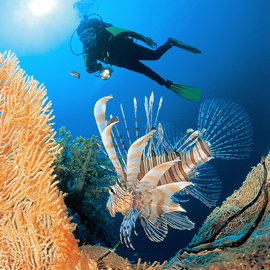What the Fish?
Posted: Feb 26 in Dive Blog tagged Specialty Diving by Jan
A beginner’s guide to fish identification
There are an estimated 21,000 species of fish in the world and getting a closer look at them is one of the major attractions of scuba diving certification. From Illinois reservoirs to Caribbean coral reefs, there are fish of countless colors, shapes and sizes awaiting you underwater.
You may be eager to learn the names of every creature you see on your dive trips, but because fish species are so diverse, it’s nearly impossible to memorize each and every one of them.
Instead, its’ best to start by learning to identify the characteristics that separate fish into distinct families like:
- Angelfish, butterflyfish and surgeonfish
- Barracuda, porgy, jacks and chubs
- Grunts and snappers
- Hamlets, chromis and damselfish
- Seabass, basslets and groupers
- Wrasse and parrotfish
- Cardinalfish, squirrelfish and bigeyes
- Gobies, jawfish and blennies
- Scorpionfish, lizardfish, frogfish and flounders
- Trumpetfish, drums, filefish, triggerfish, boxfish, puffers and goatfish
- Eels
- Rays and sharks
When you focus on the most representative species of these families in any area, you can start to classify the fish you see by family. Taking a dive class in fish identification is the best way to truly get a handle on the defining features of fish families, but once you know what you’re looking for, you can make it easier to identify fish on any dive by:
- Using your slate. Divide your slate into boxes and assign one to each family of fish you may come in contact with. When you see a fish that falls into a certain family, note it in the appropriate box and double check it with a picture when you get back to the surface. You can also leave some empty space at the bottom of your slate to sketch a fish or jot down some details and figure out the family later.
- Carrying a fish identification slate. This is a slate that offers some of the unique characteristics of each family, which can be especially helpful when you’re just starting to learn the different varieties of fish.
- Staying relaxed. Even if you’re dying for a closer look, it’s important to keep your distance and stay passive when observing underwater wildlife. Stay neutrally buoyant and do your best to seem like a natural part of the environment—when fish don’t perceive you as a threat, it will be much easier to observe them.
There are tons of fish in the sea and these tips can help you get a more in-depth look at them. Do you have any more tips for beginning fish identification after scuba diving certification? Share them in the comments below!
